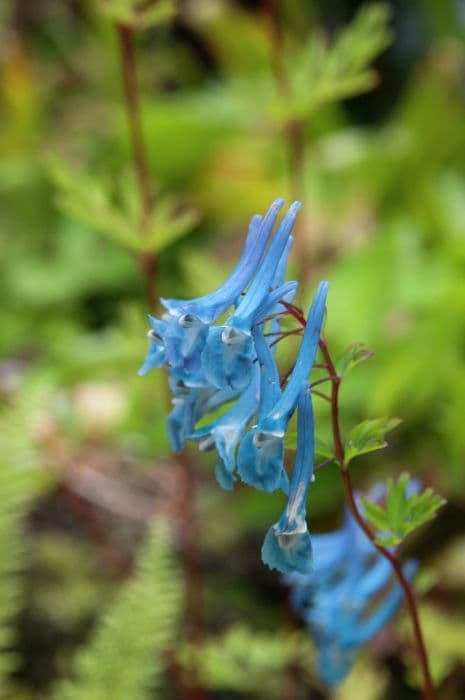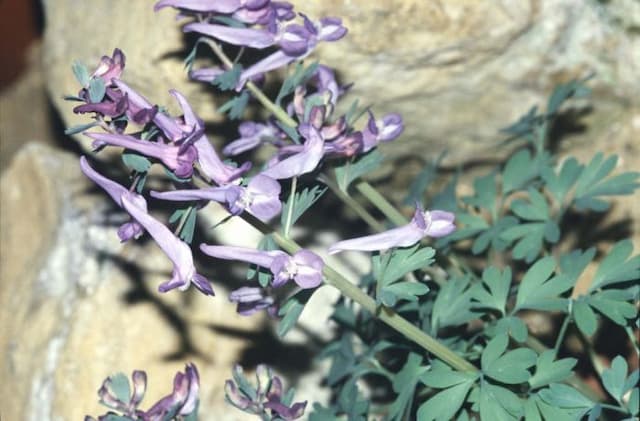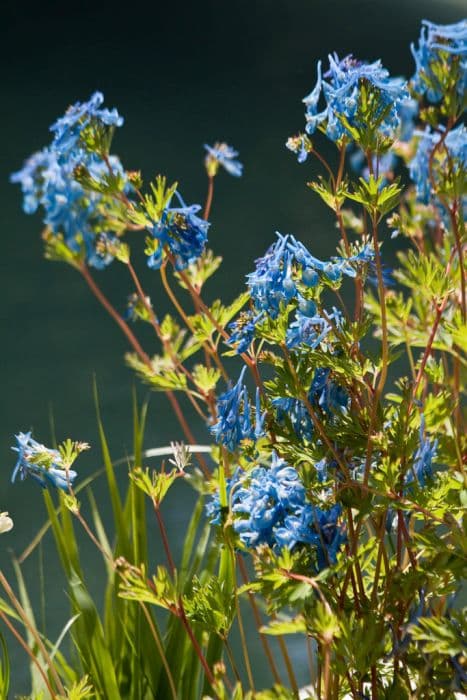Oriental Poppy Papaver (Oriental Group) 'Picotée'

ABOUT
The Papaver 'Picotée', more commonly known as an Oriental poppy, boasts a striking appearance that is distinguished by its large, sumptuous blooms. These flowers have a delicate beauty, with petals that are a vibrant shade of pink or red, often with a white or lighter edge that gives them the 'picotee' effect – a term that describes the contrasting color edging on the petals. The blooms carry a seductive, papery texture and look like they are finely crinkled, which adds to their luxurious appeal. Each flower showcases a black or deep purple blotch at its base, providing a dramatic contrast to the bright petals. This blotch is often encircled by darker, brush-like marks, which highlight the stunning architecture of the flower's core. In the center, a prominent ovary is typically surrounded by dark, powdery stamens, further accentuating the visual impact of the Oriental poppy's flowers. The leaves of the 'Picotée' Oriental poppy are equally attractive, though they perform more of a supporting role to the showy blossoms. They are typically a bluish-green color and have a hairy texture, which can make them seem somewhat silvery in the right light. The foliage grows in a clump, from which the flower stems rise to display the blossoms prominently when they are in bloom. During the blooming period, the Oriental poppy 'Picotée' lights up the garden with its intricate flowers and vibrant color, creating a focal point that draws attention and admiration. After the brief but spectacular bloom, the plant will leave behind seed pods that are also of interest for their shape and potential use in dried flower arrangements. Overall, the 'Picotée' Oriental poppy is a plant of immense beauty and character, with unique features that make it stand out in any floral setting.
About this plant
 Names
NamesFamily
Papaveraceae.
Synonyms
Picotee Oriental Poppy, Oriental Poppy 'Picotee'.
Common names
Papaver orientale 'Picotée'.
 Toxicity
ToxicityTo humans
Oriental Poppy 'Picotée' is not commonly known for severe toxicity in humans. However, poppies in general do contain alkaloids that can be toxic in large quantities. If ingested, the most common symptoms may include stomach upset, vomiting, and drowsiness. While accidental consumption of small quantities is not likely to be harmful, ingestion of larger amounts, particularly of the seeds or sap, could lead to more serious effects such as respiratory depression or nervous system effects. Care should be taken to prevent ingestion, especially in children and individuals with sensitivity to alkaloids.
To pets
Oriental Poppy 'Picotée' can be considered mildly toxic to pets if ingested. The plant contains alkaloids which, in large quantities, can cause symptoms such as gastrointestinal upset, including vomiting and diarrhea. In some cases, if a significant amount is consumed, more serious symptoms such as sedation or changes in the nervous system may occur. It is advised to keep pets away from this plant to avoid the possibility of ingestion and to seek veterinary attention if you suspect your pet has consumed a large amount of the plant.
 Characteristics
CharacteristicsLife cycle
Perennials
Foliage type
Deciduous
Color of leaves
Green
Flower color
Mixed
Height
2-3 feet (60-90 cm)
Spread
1-2 feet (30-60 cm)
Plant type
Herb
Hardiness zones
3-7
Native area
Caucasus
Benefits
 General Benefits
General Benefits- Aesthetic Appeal: Oriental Poppy 'Picotée' adds vibrant color and visual interest to gardens with its large, showy flowers that have a distinctive picotee edge, where the color is different along the margins than in the middle of the petals.
- Attracts Pollinators: This plant is attractive to bees, butterflies, and other beneficial insects, which can help pollinate other plants in the garden.
- Drought Tolerance: Once established, Oriental Poppy 'Picotée' is quite drought-tolerant, making it suitable for gardens in arid climates or for water-wise landscaping.
- Low Maintenance: The plant generally requires minimal care once it has settled in, making it a good choice for gardeners who prefer low-maintenance plants.
- Seasonal Interest: Its bloom time in late spring to early summer provides a burst of color when many other plants are just beginning to grow, bridging the gap between spring bulbs and summer perennials.
- Deer Resistant: Oriental Poppy 'Picotée' is not a preferred food source for deer, which can help to minimize browsing damage in areas where deer are a problem.
 Medical Properties
Medical PropertiesThis plant is not used for medical purposes.
 Air-purifying Qualities
Air-purifying QualitiesThis plant is not specifically known for air purifying qualities.
 Other Uses
Other Uses- Poppy seed filling: The seeds of the oriental poppy can be harvested and used as a filling in pastries and breads, providing a nutty flavor and crunch.
- Dye production: The petals of the oriental poppy can be used to create a natural dye for fabrics, yielding a range of colors from subtle pinks to deep reds.
- Educational tool: In biology classes, the large, prominent parts of the oriental poppy flower can serve as a valuable teaching aid to demonstrate plant anatomy to students.
- Art supplies: The dried seed pods of the oriental poppy can be used in art projects, providing an interesting texture and shape for collages and mixed-media artwork.
- Floral crafts: Pressed oriental poppy flowers can be incorporated into handmade paper or used to adorn greeting cards and bookmarks.
- Photography subject: The striking appearance of the oriental poppy makes it a compelling subject for photographers practicing macro and nature photography.
- Culinary garnish: Although not commonly eaten, the bright petals of the oriental poppy can add a splash of color as a garnish in gourmet dishes.
- Garden companion planting: Poppies can attract beneficial insects to the garden and can act as a trap crop, luring pests away from more valuable plants.
- Perfumery: While not a traditional source for perfumes, the oriental poppy does emit a scent that could inspire perfume makers in crafting unique fragrances.
- Seed pod arrangements: After the petals fall, the ornamental seed pods can be used in dry flower arrangements, adding an interesting element to bouquets and displays.
Interesting Facts
 Feng Shui
Feng ShuiThe Oriental Poppy is not used in Feng Shui practice.
 Zodiac Sign Compitability
Zodiac Sign CompitabilityThe Oriental Poppy is not used in astrology practice.
 Plant Symbolism
Plant Symbolism- Beauty: The Papaver 'Picotée', also known as the Oriental Poppy, features striking colors and delicate petals, symbolizing a deep appreciation for the aesthetic and visual splendor.
- Remembrance: Poppies are commonly associated with remembrance, especially of those who have fallen in war, making this particular poppy a symbol for honoring sacrifice and memory.
- Peace: After World War I, poppies became a representation of peace and the end of conflict, partly due to their growth on battlefields after the war ended.
- Resilience: Despite their delicate appearance, Oriental Poppies are hardy plants that can survive in tough conditions, symbolizing the ability to endure and bounce back from adversity.
- Rest: Poppies in general have been connected with sleep due to their sedative properties, and hence can symbolize restfulness and relaxation.
 Water
WaterOriental poppies, including the 'Picotée' variety, should be watered deeply but infrequently, allowing the soil to dry out slightly between waterings. During the growing season in spring and early summer, they typically require water once a week if there is no significant rainfall. Provide about one inch of water at each irrigation, which translates to about half a gallon per square foot. In hot and dry climates, they may need watering twice a week, while in cooler or rainy conditions, they may need less frequent watering to prevent root rot. Adequate watering is especially important during their flowering period for optimal blooming.
 Light
LightOriental poppies, including 'Picotée,' thrive best in full sun conditions, meaning at least six hours of direct sunlight each day. They prefer a spot that receives morning sun and is protected from the intense heat of late afternoon in warmer climates. However, in cooler climates, they can tolerate and appreciate sun throughout the day. Their light requirement supports the development of their showy flowers and helps maintain healthy growth.
 Temperature
TemperatureOriental poppies, such as 'Picotée,' prefer temperate climates with cool winters and moderate summers. They can tolerate winter temperatures as low as -30°F and summer temperatures up to about 90°F. However, the ideal temperature for their growth and flowering ranges between 60°F to 75°F. They are hardy perennials that can survive winter freezes but may struggle in excessively hot summer conditions.
 Pruning
PruningPruning Oriental poppies like 'Picotée' primarily involves deadheading spent flowers to encourage a tidy appearance and potentially promote a second flush of blooms in late summer or early fall. After blooming has finished for the season, usually in mid-summer, the foliage often dies back, and it can be cut back to ground level. This helps to prevent the spread of any fungal diseases and makes space for new growth.
 Cleaning
CleaningNot needed
 Soil
SoilOriental Poppy 'Picotée' thrives in well-draining soil with a mix of loam, sand, and compost to enhance fertility. The ideal pH range for this plant is 6.5 to 7.5.
 Repotting
RepottingOriental Poppies 'Picotée' are perennial plants that typically do not require repotting as they are often grown outdoors and prefer not to be moved once established.
 Humidity & Misting
Humidity & MistingOriental Poppy 'Picotée' is tolerant of a range of humidity levels and does well in average garden conditions without specific humidity requirements.
 Suitable locations
Suitable locationsIndoor
Not ideal for indoor growth; requires full sun.
Outdoor
Plant in full sun, well-draining soil, protect from strong winds.
Hardiness zone
3-7 USDA
 Life cycle
Life cycleOriental Poppy 'Picotée' begins its life as a seed that germinates in late winter to early spring, requiring a period of cold stratification to break dormancy. Once the seedling emerges, it develops a rosette of hairy, deeply lobed leaves during the spring. As temperatures increase, it produces a sturdy flower stalk, typically in late spring to early summer, upon which large, showy flowers with fringed petals and a distinctive dark blotch at the base bloom. After flowering, the plant sets seed in a capsule, and the foliage dies back, entering a period of dormancy during the heat of summer. In autumn, foliage will reappear, preparing the plant for overwintering and completing its annual growth cycle. Oriental Poppies are perennial plants, and this cycle repeats each year, with the plant growing larger and producing more flowers as it matures.
 Propogation
PropogationPropogation time
Spring-Early Summer
The Oriental Poppy 'Picotée' is a captivating perennial that takes well to propagation, particularly through division, which is the preferred method for this particular plant. Division is typically done in the late summer or early fall after the plant has finished flowering and has entered a period of dormancy. To propagate by division, the gardener should carefully lift the clump of poppy plants from the soil using a fork or shovel. It is important to minimize damage to the roots during this process. Once lifted, the clump can be gently teased apart into smaller sections, ensuring that each new section has a suitable amount of roots attached. These sections can then be replanted immediately at the same depth they were previously growing, spaced about 12 to 18 inches (roughly 30 to 45 centimeters) apart to allow for adequate growth. It is crucial to keep the soil moist but not waterlogged to help the new divisions establish.









